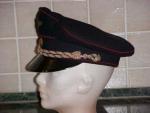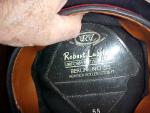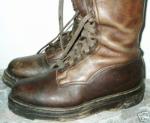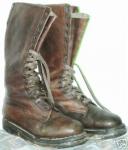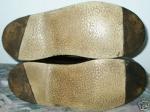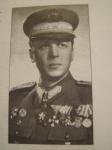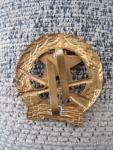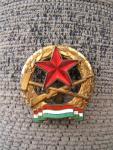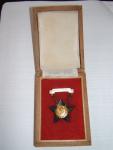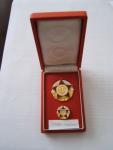-
Posts
4,807 -
Joined
-
Last visited
-
Days Won
12
Content Type
Profiles
Forums
Blogs
Gallery
Events
Store
Everything posted by Gordon Craig
-
Gents, Just saw a thread where someone mentioned they liked Reichsbahn items. They certainly do have their appeal to me, especially the early ones. I'm going to start this post today with just the hat. Notice that the peak of the cap has been "pinched in" om both sides the way Heer Third Reich hats were often worn. The hat actually dates from around 1954. Over the next few days I'll add the matching uniform and great coat that all belong to the same person. Note the name on the makers lable in the cap. More on that tomorrow!!!! Regards, Gordon
-

DDR My first DDR buys
Gordon Craig replied to Grant Broadhurst's topic in Germany: Post 1945: Bundesrepublik & DDR
Grant, These badges are just for the Kampfgruppen. They come numbered from 1 to 10 and in three grades; Silverfarbe; desgl. and bronzefarben. You mentioned books earlier. There are lots of good books in German but with the high number of pictures the language is not a problem for those who do not read German. Good luck on your DDR collection. Collecting even part of what is out there is a life long quest. Regards, Gordon -

Hungary Hungarian Post War Para Boots
Gordon Craig posted a topic in Central & Eastern European States
Gents, In case you missed these when they were on ebay here are some pictures of the leather post war Hungarian para boots. The soles are a sponge rubber with a harder rubber at the end of the heel and across the sole. The boots are not lined. There 21 holes for laces. The holes are oblong to reduce wear on the laces when being done up. I don't have a good photo of the markings in the boots, only one boot bears inspection marks, but I will post that later after some more time with my camera. The vendor sold these boots because he had a nother set. Regards, Gordon -

Hungary Hungarian People's Republic Awards
Gordon Craig replied to Ed_Haynes's topic in Central & Eastern European States
Gents, An interesting picture in line with Hunyadi's earlier post in this thread of the Partisan Association Badge. This is a picture of Alt?bornagy P?lffy Győgy wearing this early pre official Partisan's badge on his General's uniform. Also of interest is that he appears to be wearing the badge for the 1949 Anniversary Parade below it! Regards, Gordon -
Gents, Here is an interesting cap badge that I picked up last week. It measures 41mm wide (1 9/16") and 42mm high (1 11/16"). The red star appears to have been done in fired enamel. Does anyone have a picture of this cap badge/cap in wear, or better yet, a picture of an actual cap with the cap badge in place? Regards, Gordon
-

Hungary Faked Partisan Badges
Gordon Craig replied to Gordon Craig's topic in Central & Eastern European States
Hunyadi, It is possible that you are correct. I need to go back to the market again and check closer now that I have pictures of a better set of badges for reference. The two I saw certainly did not have the crisp, clean look of the Partisan badges I have seen in the past. I'll let you know what I fidn. Regards, Gordon -

Hungary Faked Partisan Badges
Gordon Craig replied to Gordon Craig's topic in Central & Eastern European States
Darrel, When I live in Canada my home is in Ottawa. At the moment, and for the next few years, I live in Budapest. The faked Partisan Badges I saw today were in a flea market here in Budapest. Regards, Gordon -
Gents, I am afraid that I have to report that I saw today, in a local flea market, what appears to be copies of the large and small Partisan Badges. I had a visitor with me and didn't have time to do a thorough inspection of the badges. I will have to do that later this week. What caught my eye on these badges was the colour. They were sort of a pink/gold colour. Very difficult to describe but certainly a long way from the silver colour of the real partisan badges. Sad day I must admit. Regards, Gordon
-

Hungary Hungarian Kivalo Dolgozol Badges
Gordon Craig replied to hunyadi's topic in Central & Eastern European States
Zolt, You indicate there was an overlap between the two badges IE "Skeleton" type used up until 68 while the "larger badges" were used from "1967 to 1969". N?PHADSEREG?NK JELV?NYEI indicates the larger badges were used from 1967 to 1969 and the small badges were introduced in 1970 which fits in with your dates. Just curious about the overlap in 67/68. Thanks for pointing out the variations in the round Kivalo Dolgozo badges. Very interesting comparison. Cheers, Gordon -

Hungary Hungarian People's Republic Awards
Gordon Craig replied to Ed_Haynes's topic in Central & Eastern European States
Charles, You must have read my mind. Great info on the award of the Partisan Badges. On the way home a few minuites ago it occured to me that I don't remember seeing a Partisan Badge award document posted. I know what they look like from the one we saw at the monthly Militaria Show. Do you have one you could post to illustrate what the document, and it's holder, should look like? It would be great reference to go with the dates of the awards you posted. Regards, Gordon -

Hungary Hungarian People's Republic Awards
Gordon Craig replied to Ed_Haynes's topic in Central & Eastern European States
Ulsterman, Yes it was at the National Museum. They keep their badges in trays about three feet square. Most of the badges were in small blue boxes with some still in the presentation case. That is how Charles was able to provide a list of some names associated with the numbered awards. The names were written on the bottom of the cases. Before that we had gone through 5 trays of Excellent Workers Badges most of which we had never seen before. The privately published book we were shown on Excellent Workers badges was also very interesting. The text on each badge was mostly taken directly from the book Charles refers to as "The Blue Bible" but the coloured pictures of the badges were really great. We have our fingers crossed that the chap from the museum will be able to put us in touch with the publisher and that he will still have two copies left to sell to us. Regards, Gordon -

Hungary Hungarian People's Republic Awards
Gordon Craig replied to Ed_Haynes's topic in Central & Eastern European States
Charles, You've been busy again! I woke up with a cold this morning so I hope I didn't give it to you yesterday. In my reply to Ulsterman and his mention of the International Brigad medal, I should have mentioned our encounter yesterday. While Charles and I were browsing through a tray of Parisan Badges, I noticed a case of different dimentions and reach over for to the other side of the tray from where I was sitting and picked up the box. Inside was? You guessed it. An International Brigad medal. What a splendid piece of workmanship. The first thing Charles said was "Look for a silver mark". My answer was "You won't find one as the medal is only silver plated and the plating is coming off". An interesting piece of information to have. Anyway, I was impressed with the high releif of the badge and the extremely good workmanship in making it. Would really like to own one of those. Cased would be nice!!!!! Regards, Gordon -

Hungary Hungarian Kivalo Dolgozol Badges
Gordon Craig replied to hunyadi's topic in Central & Eastern European States
Zolt, Thanks for posting the interior of the award documents. Nice to know what they look like. Also the picture of the early red cross abde and case. For comparison purposes, here is a picture of the case my badge came in. Regards, Gordon -

Hungary Hungarian People's Republic Awards
Gordon Craig replied to Ed_Haynes's topic in Central & Eastern European States
Gents, I'd like to add a litle to what Hunyadi had to say about yesterday morning at the National Museum. I have to second his comments about holding Partisan Badge number 1 in my hands. It is a beautifully made badge and much more striking in appearance than the others that were in the tray. Especially when they had the matching numbered miniture! Unfortunately, uncased. Charles and I are waiting impatiently to see if the museum staff can find a reference as to who was awarded this #1 badge. Perhaps, as he says, this may come to light from the State Archives. In the mean time, research presses on in many areas. Regards, Gordon -

Hungary Hungarian People's Republic Awards
Gordon Craig replied to Ed_Haynes's topic in Central & Eastern European States
Ulsterman, I don't know that Hungarian awards/badges have reached the point of being copied yet, outside of the ones mentioned earlier. The problem is that quality varies so much across the life span of some badges/awards that a poorly made item does not necessarily indicate a copy. Last week, when Charles and I visited the curator of the Numismatics/Medals section of the Military museum, we looked at a tray of Hungarian para badges ranging from WWII examples up to some current ones. There was one Communist era para badge that the curator thought might be a copy because of the colour of the green wreath. He didn't really know though as his area of expertise is not in these badges. I tended to disagree because I also own a similar badge and when examined in conjunction with 10 or 20 others it left no doubt in my mind that it was authentic. However, your point is well taken about the International Brigad medal since it isn't possible to compare several of them at once when buying such a rare bird. Regards, Gordon -

Hungary Hungarian Kivalo Dolgozol Badges
Gordon Craig replied to hunyadi's topic in Central & Eastern European States
Zolt, Very nice stuff. More things to hunt for. Miniature is very interesting. First one in this class of award that I have sen as a button hole device. Cheers, Gordon -

Hungary Hungarian Kivalo Dolgozol Badges
Gordon Craig replied to hunyadi's topic in Central & Eastern European States
Charles, Thanks for the info. Considering the rarity I got a really good deal on the red cross award. You have really made my day!!!!!!!!! Regards, Gordon -

Hungary Hungarian Kivalo Dolgozol Badges
Gordon Craig replied to hunyadi's topic in Central & Eastern European States
Charles, You didn't miss the two awards. The chap that sold them to me was just unpacking as I walked up to his table. He was in the first row on the right, just over halfway down the row. The only bandit was the guy selling the awards and his price! However, I didn't want to pass these up as I had never seen them for sale previously. Cheers, Gordon -

Hungary Hungarian Kivalo Dolgozol Badges
Gordon Craig replied to hunyadi's topic in Central & Eastern European States
Zolt, Thanks for the language lesson. Takes a long time to learn and all the help we can get is useful. Regards, Gordon -

Hungary Hungarian Kivalo Dolgozol Badges
Gordon Craig replied to hunyadi's topic in Central & Eastern European States
Ulsterman, Chip has translated the banner in an earleir post as "Ace Hungarian Worker". My dictionary indicates that ELMUNKAS is related to electrical workers but Chip is away ahead of me in the Hungarian department. I forgot to mention in my earlier post on this badge that it is numbered on the back as # 4453 and has the mark of the State Mint on it as well. The Red Cross badge is interesting because it didn't come with a miniature. Regards, Gordon -

Hungary Hungarian Kivalo Dolgozol Badges
Gordon Craig replied to hunyadi's topic in Central & Eastern European States
The interior of the botton of the case is well finished in a plush red material and a white padded lid. -

Hungary Hungarian Kivalo Dolgozol Badges
Gordon Craig replied to hunyadi's topic in Central & Eastern European States
And the last thing I bought at the City Park Flea Market this morning. A cased MAGYAR ELMUNKAS dated 1948. It came in a very nice high quality wooden case. Instead of a metal hinge the case has a piece of linen cloth to hold the lid to the base. The case is very will made with mortice and tenon joints at the corners and varnished top and bottom. -

Hungary Hungarian Kivalo Dolgozol Badges
Gordon Craig replied to hunyadi's topic in Central & Eastern European States
Here is one I haven't seen before. A Hungarian Red Cross Excellent Workers Badge. These badges come in a dark blue case. Darker than most Red Cross badges I have seen. -

Hungary Hungarian Kivalo Dolgozol Badges
Gordon Craig replied to hunyadi's topic in Central & Eastern European States



